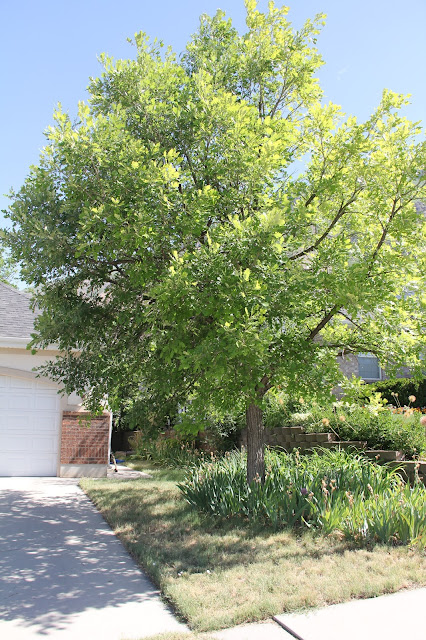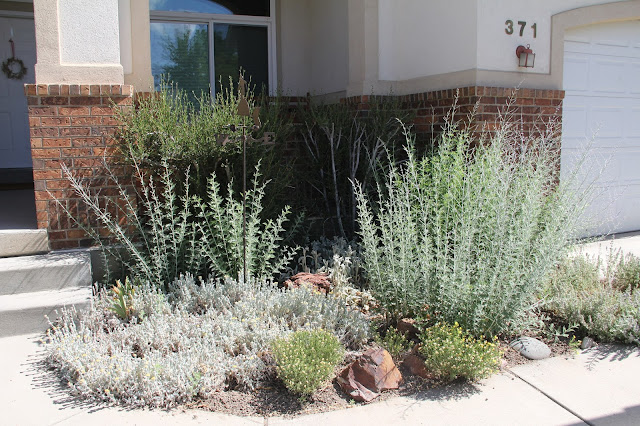A xeriscaped yard in a time of severe drought.
When we selected a lot and built a house in Springville in 1998. I
decided (and Marie approved) since we lived in a steppe climate with an
average of about 16 inches of rainfall a year that we should do our part
to conserve water. Xeriscape was a new word for me. It derives from the
Greek word Xeri meaning dry. So xeriscaping means a style of
landscaping that requires little on no irrigation and is thus used in
arid/dry climates. Some people mistakenly think that xeriscaping means
zeroscaping in that there are zero/no trees or plants, just rocks and
dirt. Landscaping with rocks is one way to xeriscape but so is
landscaping with drought tolerant plants. That is the route I chose to
take. We moved in in June and through that summer I did my research in
anticipation of planting grass, trees and shrubs in the fall. All plants planted can technically survive on Utah's normal amount of "moisture". Sadly there have been few normal years in the past 23 years.
1998. Newly planted plants include: Chokecherry, Catalpa, Allium, Pinon Pine, Apricot, Iris, Russian Sage and Buffalo Grass. I xeriscaped the front yard (south) and the east and west sides of the house. In the back yard we had sprinklers installed and laid Kentucky Blue Grass sod.
To read more about my gardening adventures see this blog post: https://beitemmett.blogspot.com/2012/04/parable-of-hopeful-gardener.html
June 2021 after a very dry winter and spring.
After hauling in and leveling loads of top soil and much, I ordered 1700 plugs of Buffalo Grass (native to the high plains of North America where the buffalo roam) from High Country Gardens in New Mexico. High Country Gardens
Each plug sent out runners that within a few months filled in to form a nice turf--not quite as lush as Blue Grass, but it is barefoot walk-able.
This was the first mowing that next spring. Unlike all of our neighbors who put in sprinklers and laid Kentucky Blue Grass sod in their front yards, we did not install a sprinkling system in our front yard. In good years when there is sufficient snowfall and then spring rain, our buffalo grass greens up by June (later that Kentucky Blue Grass) and looks like a normal lawn. To keep it green I usually just need to water about once a week in July and August. A nice surprise is that one watering can turn the lawn from its dry looking wheat color to green. It doesn't die from not being watered, it just loses its green color until watered again. The section of lawn closest to a rain gutter downspout is always the greenest and thickest, but the less watered areas persist. The grass grows to about 4 inches high. I don't mind the prairie look, but usually about once a month I give it a mow to make us fit in with our neighbors' lawns for at least a few weeks.
In a January without snow. Its dormant color.
After spring rains. Since the turf is not as dense as Blue Grass, other grasses and weeds like to creep in. I pull what I can (easiest after a rain) and I spray the never ending bind weed (morning glory). A good mowing turns the rough prairie into a respectable lawn.
Last summer after a month of growth (above) then mowed (on the highest setting) and edged (below). You can see the runners sent out across the side walk.
The lawn in June 2021 with no watering and almost no rain.
The lawn on July 24, 2021 with no watering and no rain for several months. I did soak the trees a few times during the summer to keep them alive.
The lawn at the end of August 2021with no watering but after a week of several rain storms. It greened up within a few days of a few good rains.
Grape hyacinths and daffodils in bloom (March 26, 2020).
Always happy when it snows and I can pile the shovelings on the grass to provided additional free water.
Since I knew the grass would green up later than regular grass I decided to plant early spring bulbs under the grass. Every spring all kinds of flowers bloom (and propagate) while the grass is still dormant.
First to bloom are snow drops (sometimes as early as January if there is limited snow), then crocus and then grape hyacinths. No sign remains of them after the first mowing.
I used this Xeriscape Plant Guide to help me figure out what grass, plants and trees I wanted to plant. The High Country Garden catalogues also gave me great ideas. Also helpful were publications from USU extension that had recommendations for all kinds of native plants and drought tolerant plants to use. Twenty years ago there were fewer sources and nurseries that catered to xeriscaping needs, but now there are many more sources of information and plants. I think you can even buy buffalo grass sod in some places.
Swamp White Oak (2021)
Curl Leaf Mountain Mahogany in the back as a hedge. Another taller one grows on the west side.
Russian sage blooms for months and are loved by bees. When I planted these, they were a rarity in Utah. Now I see them everywhere. They do very well in the dry and heat.
Catalpa
On the east side I planted lost of Iris around the oak tree and along the retaining wall we built.
Volunteer basket of gold in the retaining wall.
On the west side, there was not enough sun for the buffalo grass to thrive and eventually the vinca major (myrtle) I planted (starts from my parent's yard) took over. The aspen has done well here too, I think because it does not get regular waterings. Many neighbors planted aspens in well watered yards but almost all have died--perhaps too much water.
Here are some of the other plants that pop up and bloom during the year:
A recent favorite that I planted when our Scotch Brooms died off. This is a Gwen's Buffalo Currant. Its blossoms have a clove scent and it produces large tasty currants.
Lavender
Day lilies
Volunteer allium from two mother bulbs planted 23 years ago.
My first two apricot trees were killed by bores.
Always happy to see praying mantises in our yard.










 .
. 











































Xeriscaping in Menlo Park is a fantastic way to create beautiful gardens while conserving water.
ReplyDeletexeriscaping landscaping ideas in Menlo park